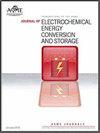Cu-Ga合金的可控脱合金及其作为锂离子电池负极材料的应用
IF 1.9
4区 工程技术
Q3 ELECTROCHEMISTRY
Journal of Electrochemical Energy Conversion and Storage
Pub Date : 2022-09-21
DOI:10.1115/1.4055695
引用次数: 0
摘要
多孔金属材料因其低密度、高效的离子/电子路径和高比表面积而被广泛应用于锂离子电池电极。在本研究中,我们以Cu- ga合金为基础,采用化学和电化学脱合金的方法制备了纳米多孔Cu。讨论了脱合金条件对纳米多孔金属衍生微观结构的影响及其演化机制。对电化学脱合金过程的分析和控制表明,样品的形貌是可以调节的,相组分是可以控制的。在此基础上,可控合成了具有纳米孔结构的三维CuGa2电极,该电极作为锂离子电池阳极具有比二维CuGa2电极更高的比容量和循环稳定性。本文章由计算机程序翻译,如有差异,请以英文原文为准。
Controllable dealloying of a Cu-Ga alloy and its application as an anode material for lithium-ion batteries
Porous metallic materials are widely used for lithium-ion battery (LIB) electrodes because of their low density, efficient ionic/electron pathways, and high specific surface area. In this study, we fabricate nanoporous Cu using chemical and electrochemical dealloying methods based on a Cu-Ga alloy. The effects of the dealloying conditions on the derived microstructure of the nanoporous metal and its evolution mechanisms are discussed. Analysis and control of the electrochemical dealloying process reveal that the sample morphology can be adjusted and the phase component can be controlled. Accordingly, a 3D CuGa2 electrode with a nanoporous structure is controllable synthesized, and it exhibits a higher specific capacity and cyclic stability than a 2D CuGa2 electrode when used as a LIB anode.
求助全文
通过发布文献求助,成功后即可免费获取论文全文。
去求助
来源期刊

Journal of Electrochemical Energy Conversion and Storage
Engineering-Mechanics of Materials
CiteScore
4.90
自引率
4.00%
发文量
69
期刊介绍:
The Journal of Electrochemical Energy Conversion and Storage focuses on processes, components, devices and systems that store and convert electrical and chemical energy. This journal publishes peer-reviewed archival scholarly articles, research papers, technical briefs, review articles, perspective articles, and special volumes. Specific areas of interest include electrochemical engineering, electrocatalysis, novel materials, analysis and design of components, devices, and systems, balance of plant, novel numerical and analytical simulations, advanced materials characterization, innovative material synthesis and manufacturing methods, thermal management, reliability, durability, and damage tolerance.
 求助内容:
求助内容: 应助结果提醒方式:
应助结果提醒方式:


